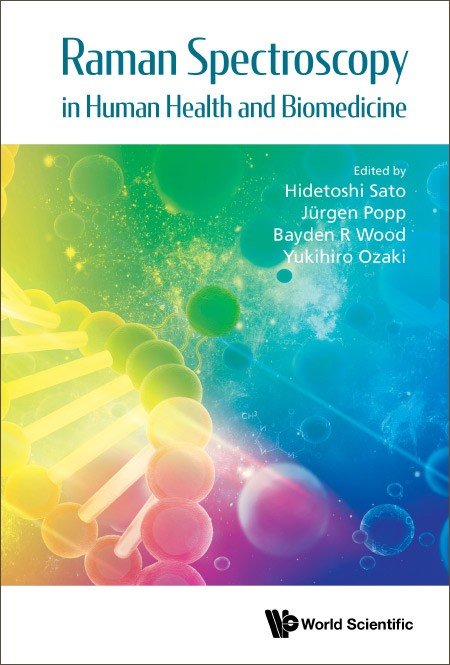Since the inelastic scattering of light was predicted nearly 100 years ago, Raman spectroscopy has become a mainstay of characterization techniques, with applications in a vast array of fields from chemistry to materials science and nanotechnology, from forensics to geology and art. More recently, it has found usage in the life sciences, and this book hereby outlines the state-of-the-art advances in applications of Raman spectroscopy to human health and biomedicine. It covers a wide range of human health science including medicine (especially cancer), physiology, biological molecules, pharmaceutical science, cells, viruses, microorganisms, and food science. Another highlight is that it describes recent progress on various Raman techniques such as surface-enhanced Raman scattering, tip-enhanced Raman scattering, non-linear Raman spectroscopy, Raman microscopy, and Raman imaging. Novel spectral analysis methods such as chemometrics are also prominently discussed.
Sample Chapter(s)
Preface
Chapter 1: History of Challenges of Raman Spectroscopy to Medical Science — From 1970s to 2000
Contents:
- History of Challenges of Raman Spectroscopy to Medical Science — From 1970s to 2000 (Yukihiro Ozaki)
- Photonic Data Science for Raman Data Analysis (Rola Houhou, Thomas Bocklitz)
- Chemometric Treatment of Raman Spectra in Biomedicine and Food Science (Ángel Sánchez-Illana, David Pérez-Guaita)
- Raman Spectroscopy and Machine Learning as a Potential Universal Diagnostic Technique (Nicole M Ralbovsky, Igor K Lednev)
- Raman Spectroscopy for Health Science (Mariko Egawa)
- Non-destructive Analytical and Structural Studies of Lipids in Food, Health, and Biomedical Sciences by Raman Spectroscopy (Hidetoshi Sato, Yukihiro Ozaki)
- Point-of-Care Detection Strategies Aligned to Human Health Using Surface-Enhanced Raman Spectroscopy (Sian Sloan-Dennison, Hayleigh Kearns, Waleed Hassanain, Karen Faulds, Duncan Graham)
- Raman Imaging and Screening of Bioactive Small Molecules (Hiroyuki Yamakoshi, Jun Ando, Syusuke Egoshi, Kosuke Dodo, Mikiko Sodeoka, Katsumasa Fujita)
- Coherent Anti-Stokes Raman Scattering (CARS) Microscopy and its Applications in Life Sciences (Shinichi Miyazaki, Yusuke Murakami, Sakiko Honjoh, Yu Hayashi, Hideaki Kanoi)
- Raman Spectroscopy for Infection Diagnosis (Markus Salbreiter, Aikaterini Pistiki, Dana Cialla-May, Petra Rösch, Jürgen Popp)
- Raman Spectroscopy Applied to Antimicrobial Resistance (Kamila Kochan, Savithri Pebotuwa, Thulya Chakkumpulakkal Puthan Veettil, Anton Y Peleg, Xenia Kostoulias, Bayden R Wood)
- Raman Spectral Cytopathology for Cancer Diagnostic Applications (Fiona M Lyng, Damien Traynor, Isha Behl, Declan O'Dea, Hugh J Byrne)
- Exploring the Hidden Realms: New Frontiers for Raman Spectroscopy in Life Sciences (Jeong Hee Kim, Swati Tanwar, Zhenhui Liu, Ishan Berman)
- Translating Biomedical Raman Spectroscopy into Clinical Endoscopic Diagnosis and Post-Treatment Monitoring in Head and Neck Cancer Patients (Chi Shu, Wei Zheng, Kan Lin, Zhiwei Huang)
- Raman Probe and Live Tissue Analysis for Monitoring Biological Activity (Akinori Taketani, Hidetoshi Sato)
- Clinical Aspects of Raman Spectroscopy in Surgical Applications (Katherine Ember, Jean-Philippe Dulude, Trang Tran, Mai-Kim Gervais, Sarkis Meterissian, Roy Dudley, Kevin Petrecca, Frédéric Leblond)
- Exploring Cancer with Raman Spectroscopy: Principles, Progress, and Challenges (Christoph Krafft, Jürgen Popp)
Readership: Academics, researchers, lecturers, and graduate students in spectroscopy and data science. Doctors and allied health professionals will also be interested.
"The book is very interesting and will provide a different scope as compared with other books in the literature. It will be a good general book for people working on Raman spectroscopy of biomedical and health sciences. The Editors are top scientists in their own fields."
Zexiang Shen
Professor, Nanyang Technological University, Singapore
"... By providing insights into the future prospects of Raman spectroscopy analysis techniques, this book serves as a valuable resource for both research and practical applications... Yukihiro Ozaki received the Charles Mann Award for Applied Raman Spectroscopy in 2020 for his contributions to the medical applications of Raman spectroscopy. Similarly, Jürgen Popp was awarded the same honor in 2023 for his achievements in biomedical applications and imaging. As such, this book includes two award-winning editors who have led the field of Raman spectroscopy in life science applications, making it a comprehensive resource that covers the mainstream advancements in this area."
The Review of Laser Engineering

Dr Hidetoshi Sato is Professor at Kwansei Gakuin University, Japan. He was previously Research Unit Leader at RIKEN, Japan. His research focuses on the development of new instruments and analytical techniques of optical spectroscopy to explore mechanisms, dynamism and metabolism of live cells and tissues. He is a council member of The International Society for Clinical Spectroscopy (CLIRSPEC) and a member of the editorial committee of The Laser Society of Japan. He has published more than 60 peer-reviewed papers and 2 book chapters.

Dr Jürgen Popp FRSC is Chair Professor of Physical Chemistry at Friedrich-Schiller University Jena, Germany. He is also the Scientific Director of the Leibniz Institute of Photonic Technology, Germany. He is an Elected Fellow of the Royal Society of Chemistry, UK, and the American Institute for Medical and Biological Engineering, USA. He is Editor-in-Chief of the Journal of Biophotonics.
Professor Popp is a world-leading expert in biophotonics / optical health technology covering the complete range from photonic basic research to translation into clinically applicable methods. He has published more than 960 journal papers, named as an inventor on 12 patents and given more than 200 invited talks on national and international conferences (among them more than 50 keynote/plenary lectures). He has received many prestigious accolades, including an honorary doctoral degree from Babeş-Bolyai University in 2012, the 2013 Robert Kellner Lecture Award, the 2016 Pittsburgh Spectroscopy Award, the 2018 Ioannes Marcus Marci Medal of the Czechoslovak Spectroscopy Society, the 2018 Kaiser Friedrich Research Prize, and the 2019 Ralf Dahrendorf Prize.

Dr Bayden R Wood FRSC is Professor at Monash University, Australia, where he is also the Director for the Centre of Biospectroscopy. He is an Elected Fellow of the Royal Society of Chemistry, UK, and the Royal Australian Institute of Chemistry (RACI), Australia. He is Founder and Director of the International Society for Clinical Spectroscopy, and recipient of the 2014 RACI Doreen Clark Medal for Analytical and Environmental Chemistry. His research is focused on translating vibrational spectroscopic techniques to solve a range of biomedical and clinical research problems particularly associated with disease diagnosis. He has published over 180 papers, 11 book chapters and co-edited 1 book, with a h-index of 52.

Dr Yukihiro Ozaki FRSC is Professor Emeritus at Kwansei Gakuin University, Japan, where he was previously Vice-President of the University. He is also Guest Professor at Kobe University, Japan; and Guest Scientist at RIKEN, Japan and Toyota Physical and Chemical Research Institute, Japan. He is an Elected Fellow of the Royal Society of Chemistry, UK, Society for Applied Spectroscopy, USA, Chemical Society of Japan, and International Council of Near-Infrared Spectroscopy.
Professor Ozaki has received many prestigious awards over the years, of which the most illustrious is the Medal of Honor bestowed by the Emperor of Japan in 2018. Others include the 2014 Bomem-Michelson Award, the 2017 Chemical Society of Japan Award, the 2019 Pittsburgh Spectroscopy Award, the 2020 Charles Mann Award of Applied Raman Spectroscopy, and the 2021 Karl Norris Award, and the 2022 Ioannes Marcus Marci Medal. He has authored/edited 16 books and published more than 1,000 peer-reviewed papers, with a h-index of 84.









